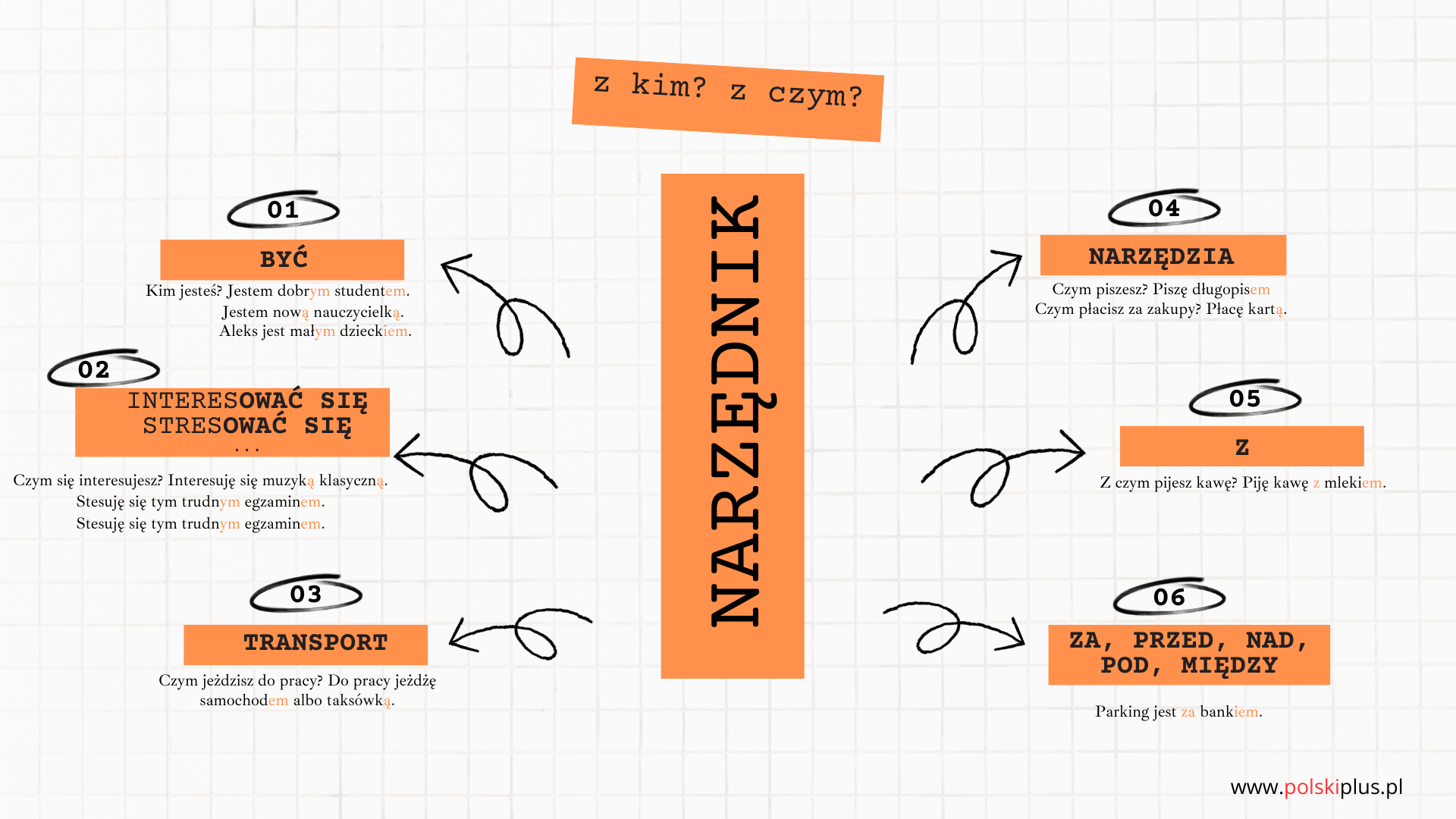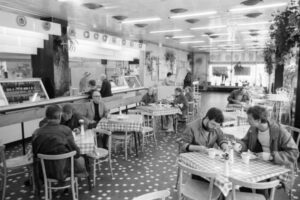
All you need to know about NARZĘDNIK
The instrumental case, narzędnik is one of the seven cases in the Polish language. While it may not be the most frequently employed case, it is often introduced to foreigners at the outset due to its relatively straightforward nature. It features fairly regular endings and clear usage rules, making it an accessible starting point for learners.
ENDINGS
If a sentence necessitates the use of the instrumental case, both the noun and the adjective will undergo changes in their endings to conform to the requirements of this case.
NOUNS ENDINGS
SINGULAR NOUNS in the instrumental case (narzędnik) typically take the following endings:
Masculine: -em (or –iem if the noun ends with k or g)
On jest studentem / Polakiem. (He is a student / He is Polish)
Feminine: -ą
Ona jest studentką. (She is a student)
Neuter: -em (or –iem if the noun ends with k or g)
Warszawa jest miastem / Ono jest dzieckiem. (Warsaw is a city / It is a child)
As you can observe, the endings for masculine and neuter nouns are the same.
For PLURAL NOUNS, the endings are the same for all genders and are typically “-ami“:
Oni są cudzoziemcami. (They are foreigners.)
One są studentkami. (They [feminine] are students.)
One są dziećmi. (They [neuter] are children; note the alternation where “a” is reduced in this case ).
ADJECTIVES ENDINGS
SINGULAR ADJECTIVES in the instrumental case (narzędnik) typically take the following endings:
Masculine: -ym (or -im if the noun ends with k or g)
On jest dobrym studentem / wysokim chłopakiem. (He is a good student / tall boy)
Feminine: -ą
Ona jest inteligentną studentką. (She is an intelligent student)
Neuter: -ym (or -im if the noun ends with k or g)
Warszawa jest dużym/polskim miastem. (Warsaw is a big/Polish city)
Same as for nouns, the endings for masculine and neuter adjectives are the same in the instrumental case.
For PLURAL ADJECTIVES, the endings are the same for all genders and are typically “-ymi” (or “-imi” if the adjective ends with k or g):
Oni są wesołymi cudzoziemcami. (They are cheerful foreigners.)
One są energicznymi / wysokimi studentkami. (They [feminine] are energetic / tall students.)
Warszawa i Kraków są polskimi miastami. (Warsaw and Krakow are Polish cities.)
It’s important to note that these adjective endings change only if there is a noun in the sentence. If the adjective stands alone, the ending remains the same (narzędnik is not applied), as illustrated in the example:
Paweł jest kreatywnym nauczycielem. (Paweł is a creative teacher.)
Paweł jest kreatywny. (Paweł is creative.)
EXCEPTIONS
There are a few nouns in Polish that exhibit atypical behavior when they are inflected into the instrumental case (narzędnik). These nouns are masculine but have the ending “-a,” which typically follows feminine declension patterns. This results in a somewhat unusual mix of gender forms when the instrumental case is applied. In such cases, the noun itself changes its endings as if it were feminine, but also necessitates the adjective to change in a masculine form.
For example:
On jest sympatycznym (masculine ending -ym) tatą (feminine ending -ą). (He is a likable father.)
In this sentence, “tata” is a masculine noun ending with “-a,” but when it shifts into the instrumental case, it temporarily takes on the endings typical for feminine nouns. This, in turn, influences the adjective “sympatycznym” to adopt masculine endings.
NAMES AND SURNAMES
It’s important to note how names and surnames behave when it comes to the instrumental case (narzędnik) in Polish. Names typically change like nouns, while surnames can change based on their typical adjective or noun endings.
For NAMES, they generally change like nouns:
Idę na randkę z Adamem / z Karoliną. (I’m going on a date with Adam / with Karolina.)
However, there are some names that, due to their typical adjective-like endings (-ni, -cy), change like adjectives:
Idę na randkę z Antonim / z Ignacym. (I’m going on a date with Antoni / with Ignacy.)
Similarly, SURNAMES that have endings typical of nouns change like nouns, and those with endings typical of adjectives change like adjectives:
To jest Jan Kot. Idę na spotkanie z Janem Kotem. (This is Jan Kot. I’m going to a meeting with Jan Kot.)
To jest Jan Kowalski. Idę na spotkanie z Janem Kowalskim. (This is Jan Kowalski. I’m going to a meeting with Jan Kowalski.)
However, be cautious with surnames ending with a consonant that are carried by women. They do not change. On the other hand those ending with a vowel will generally change along with the regular instrumental case pattern:
To jest Anna Kot. Idę na spotkanie z Anną Kot. (This is Anna Kot. I’m going to a meeting with Anna Kot.)
To jest Anna Kowalska. Idę na spotkanie z Anną Kowalską. (This is Anna Kowalska. I’m going to a meeting with Anna Kowalska.)
QUESTIONS
It’s important to remember that some of the words typically used to form questions will also change when the instrumental case (narzędnik) is applied. If the instrumental case is used in the answer, it must be also used in the question.
Kto? —> Kim?
Co?—> Czym?
Jaki? —> Jakim?
Jaka?—> Jaką?
Jakie?—> Jakim?
|
MIANOWNIK | NARZĘDNIK |
|
Kto to jest? To jest lekarz. |
Kim on jest? On jest lekarzem |
|
Co to jest? To jest długopis. |
Czym piszesz? Piszę długopisem. |
|
Jaki jest ten samochód. Ten samochód jest biały. | Jakim samochodem jeździsz do pracy? Do pracy jeżdżę czerwonym samochodem. |
|
Jaka jest Anna. Anna jest ambitna. |
Jaką studentką jest Anna? Anna jest ambitną studentką. |
| Jakie jest to miasto? To miasto jest piękne. |
Jakim miastem jest Warszawa? Warszawa jest pięknym miastem. |
PERSONAL PRONOUNS
At this point, it should not come as a surprise that personal pronouns also undergo changes when the instrumental case (narzędnik) is applied.
|
MIANOWNIK | NARZĘDNIK |
|
ja |
MNĄ – Idziesz ze mną do kina? |
|
ty |
TOBĄ – Chcę iść z tobą na spacer. |
|
on |
NIM – Lubię z nim rozmawiać. |
|
ona |
NIĄ – Lubię z nią spędzać czas. |
|
ono |
NIM – Idę z nim do lekarza. |
|
my |
NAMI – Chcesz jechać z nami do Polski? |
|
wy |
WAMI – Nie idę z wami do kina. |
|
oni |
NIMI – Pracuję z nimi już kilka lat. |
| one |
NIMI – Pracuję z nimi już kilka lat. |
USAGE
The use of the instrumental case depends on the context of the sentence, the verbs and prepositions that occur in the sentence.
The instrumental case is used with the verb “BYĆ” (to be) throughout its conjugation and in all tenses. This means that the instrumental case is applied in sentences with verbs like “jestem” (I am), “jesteś” (you are), “byłem” (I was), “byłeś” (you were), “będę” (I will be), “będziesz” (you will be), and so on.
For example:
On jest dobrym sąsiadem. (He is a good neighbor.)
On był dobrym sąsiadem. (He was a good neighbor.)
On będzie dobrym sąsiadem. (He will be a good neighbor.)
There are two exceptions to this rule:
- The instrumental case is not applied if the word “TO” (this) is in the sentence:
On jest ambitnym studentem. (He is an ambitious student.)
To jest ambitny student. (This is an ambitious student.)
- The instrumental case is not applied if there is a standalone adjective without a noun, as previously mentioned:
On jest ambitnym studentem. (He is an ambitious student.)
On jest ambitny. (He is ambitious.)
Narzędnik is also following verbs ending with -ować + się, for example: “INTERESOWAĆ SIĘ“, denerwować się,” “stresować się,” “opiekować się,” “zajmować się”.
For example:
Czy interesujesz się językiem polskim? (Are you interested in the Polish language?)
Czy interesowałeś się językiem polskim? (Were you interested in the Polish language?)
Czy będziesz interesować się językiem polskim? (Will you be interested in the Polish language?)
The usage of the instrumental case (narzędnik) in Polish also depends on the context:
The instrumental case specifies the tool, instrument, or method used to carry out an action. The name of this case, “narzędnik,” is derived from the word “narzędzie,” which means “tool.”
For example:
Piszę długopisem. (I am writing with a pen.)
It is often used with subjects related to transport, treating the transportation vehicle as a tool or method used to move around:
Jadę do pracy samochodem. (I am going to work by car.)
In English, this is often equivalent to using the preposition “with” or “by.” However, it’s important to remember that in such situations, the word “with” is not translated to Polish, as its meaning is already conveyed by the instrumental case endings:
“I pay by card.” — “Płacę kartą.”
The instrumental case (narzędnik) in Polish is also used after several Polish prepositions:
Z (with) – Narzędnik is used after the preposition “z” when it implies adding something or companionship. For example:
To jest kawa z mlekiem. (This is coffee with milk.)
Idę do kina z Karoliną. (I’m going to the cinema with Karolina.)
It’s important to note that the Polish preposition “z” can have two meanings – “with” and “from.” The instrumental case is not used when “z” is translated as “from.” For example:
Jestem z Polski. (I am from Poland.) In this example, a different case- genitive (dopełniacz), is used.
In some cases, when a noun begins with a group of consonants “e” is being added to “z”- Jem pierogi ze szpinakiem. (I eat pierogi with spinach).
The instrumental case is used after some prepositions to indicate location or direction, and it’s an essential aspect of Polish grammar when describing spatial relationships:
ZA (behind), PRZED (in front of), NAD (above), POD (under), MIĘDZY (between) – These prepositions are often referred to as “localization prepositions,” and they also require the use of the instrumental case. For example:
Za parkiem jest sklep. (Behind the park, there is a store.)
Przed drzwiami czeka kurier. (In front of the door, there is a courier.)
Nad stołem wisi lampa. (Above the table, there hangs a lamp.)
Pod łóżkiem leży kot. (Under the bed, there lies a cat.)
Między kanapą a fotelem stoi lampa. (Between the sofa and the armchair, there stands a lamp.)
At first glance, all of these rules may appear somewhat complicated, especially for learners who are not familiar with any other language that uses grammatical cases. However, as you continue to learn, it will become easier and easier. In the beginning, it’s helpful to become familiar with the rules for using the instrumental case (narzędnik) and to memorize its endings. With time, it will become second nature, and you will use it effortlessly, even without consciously thinking about it.



